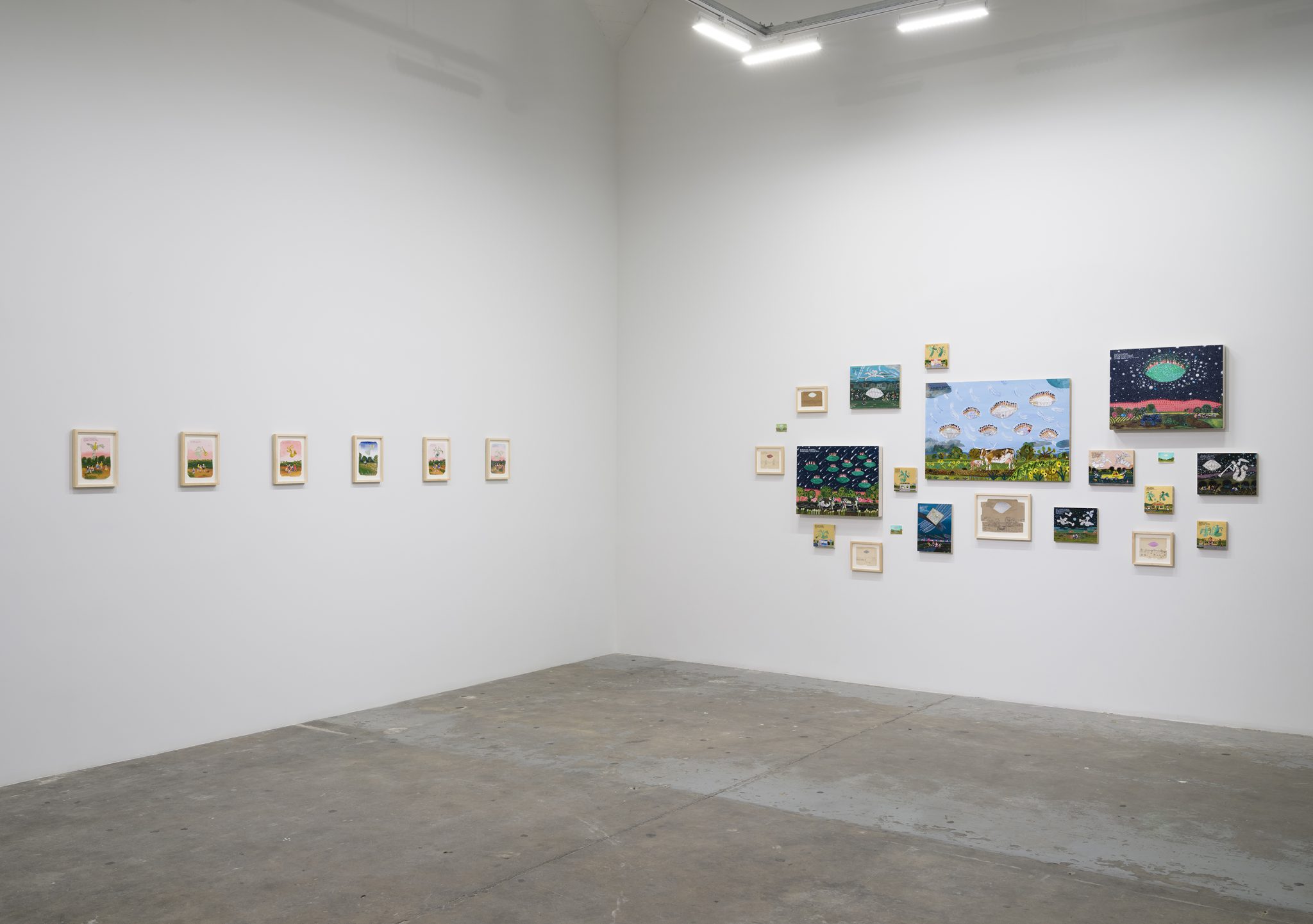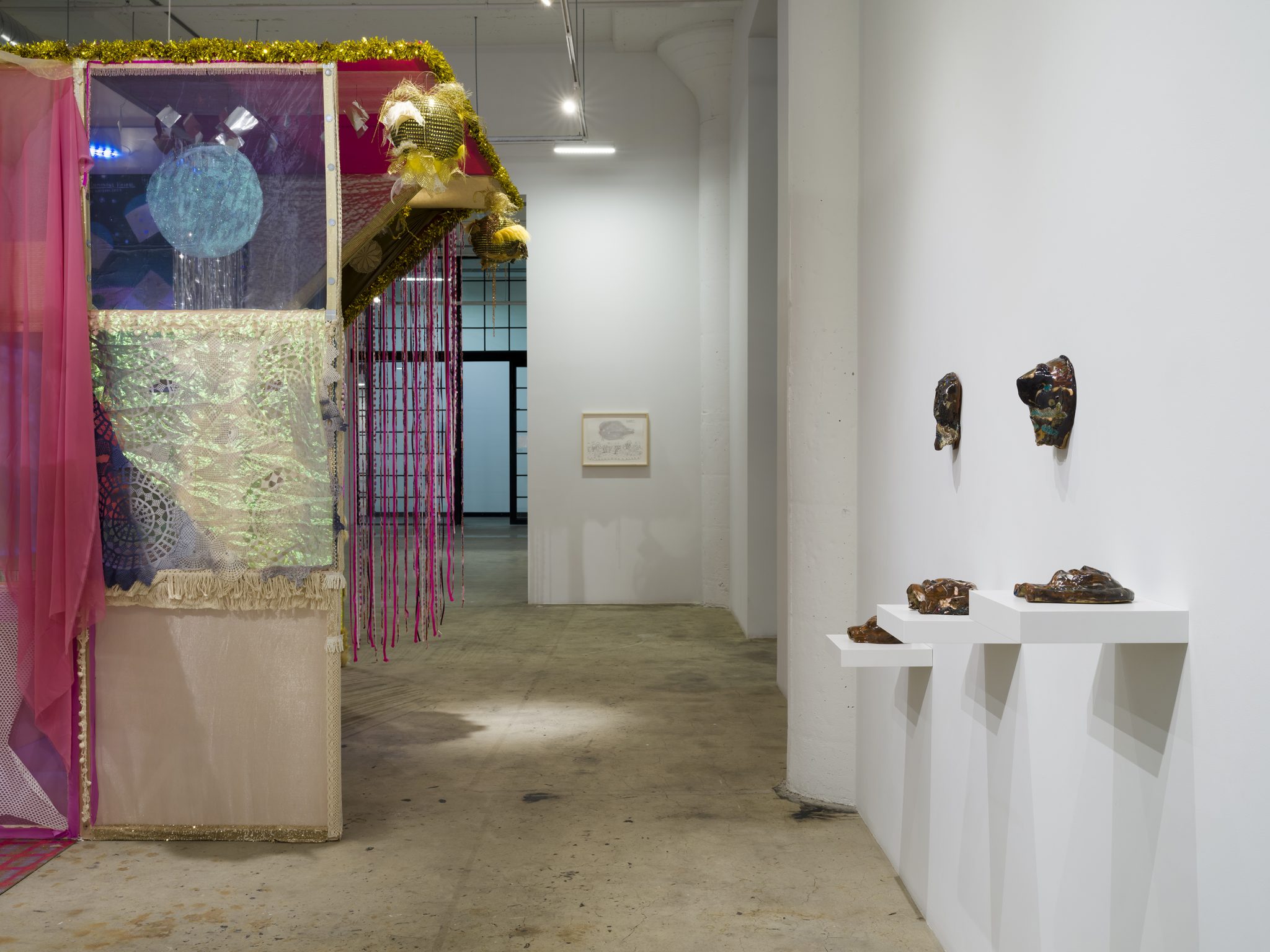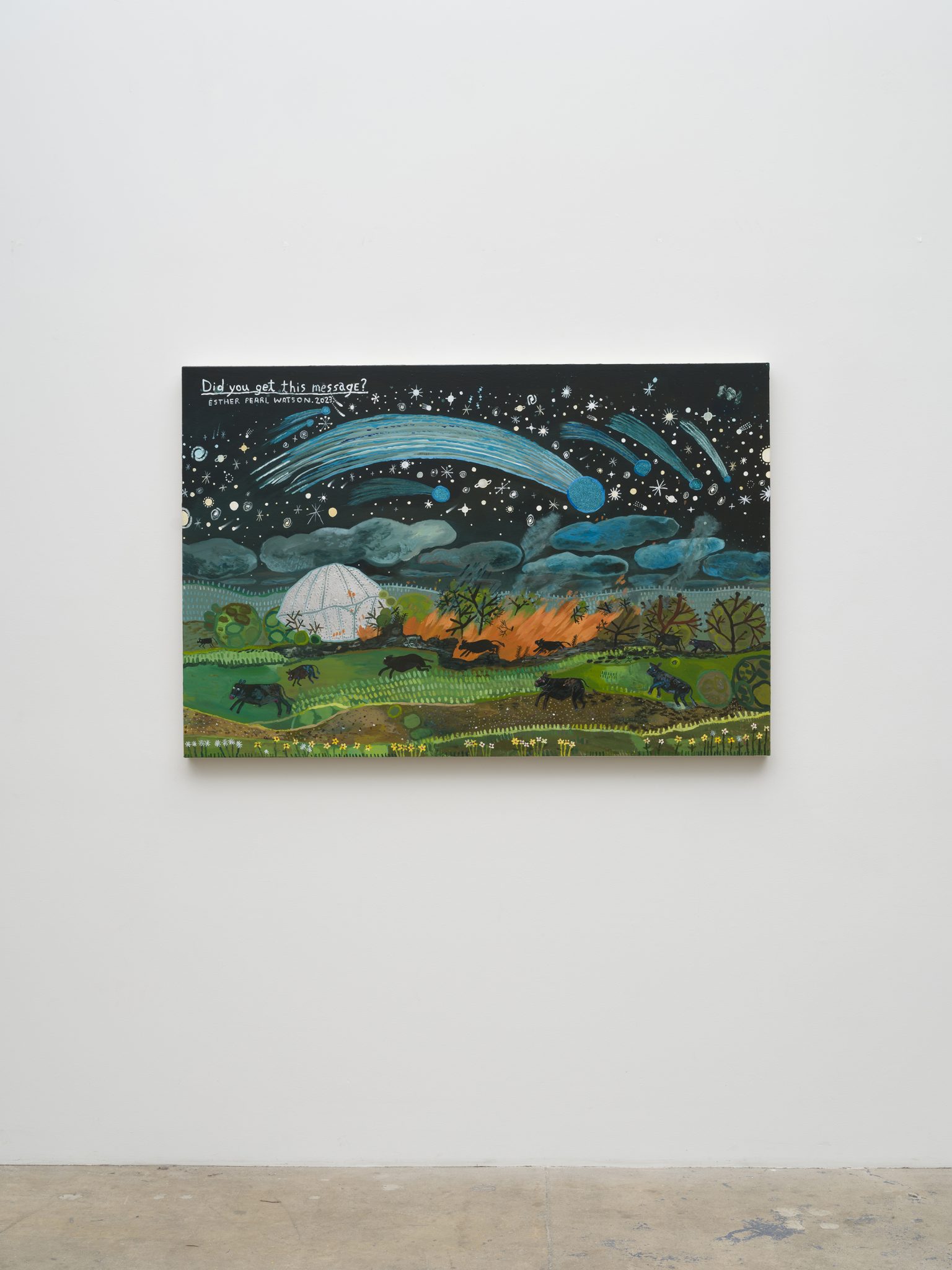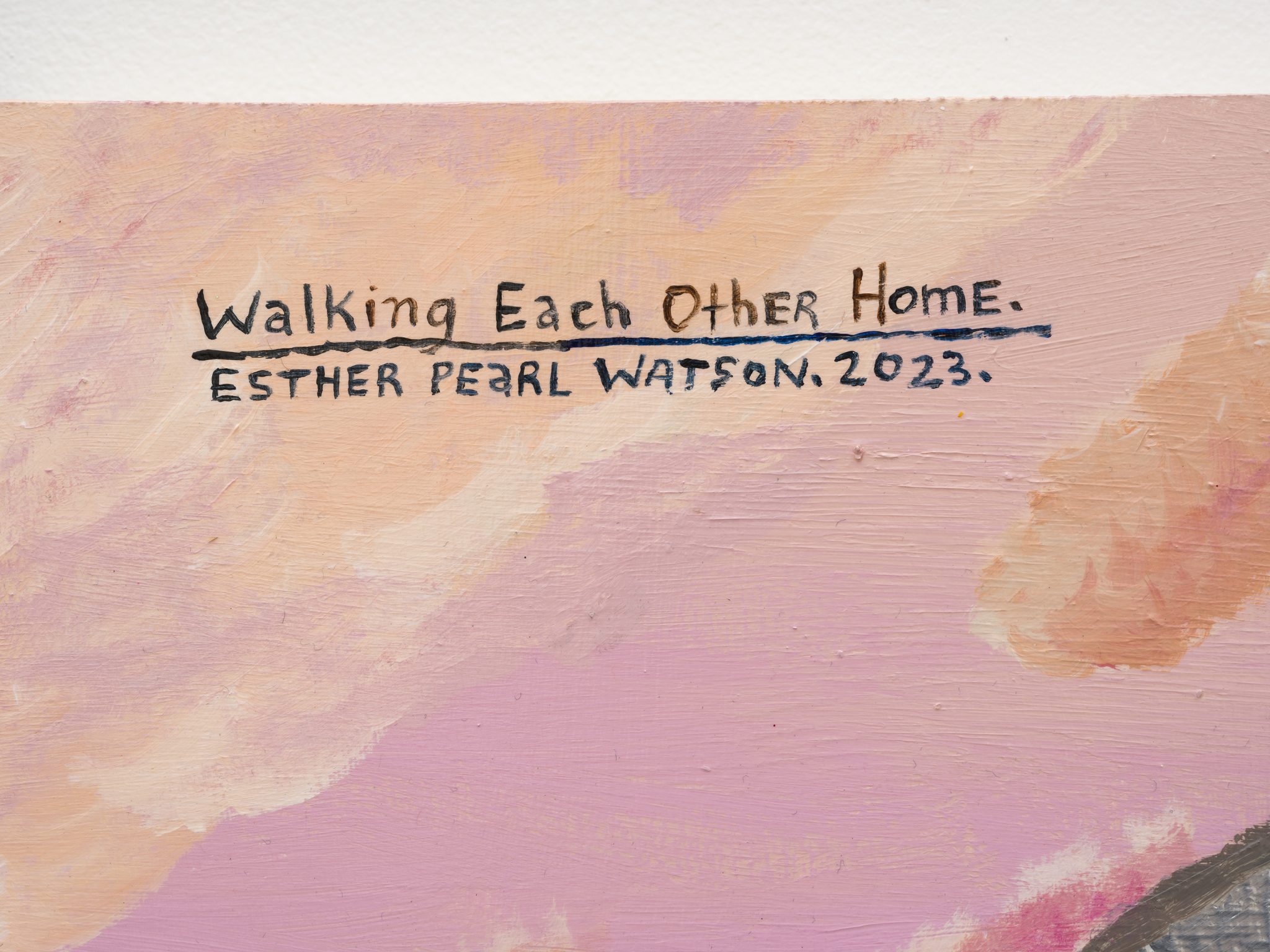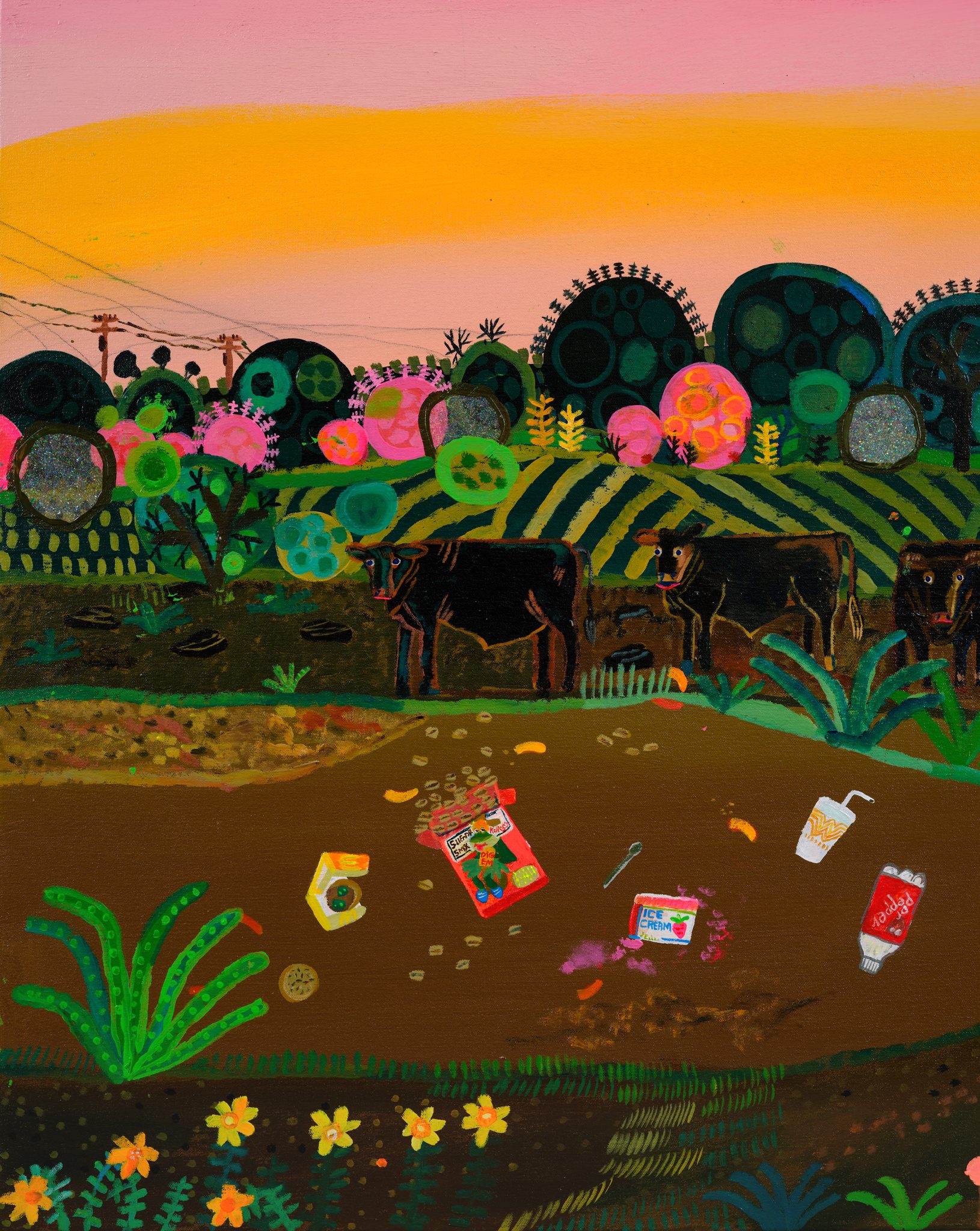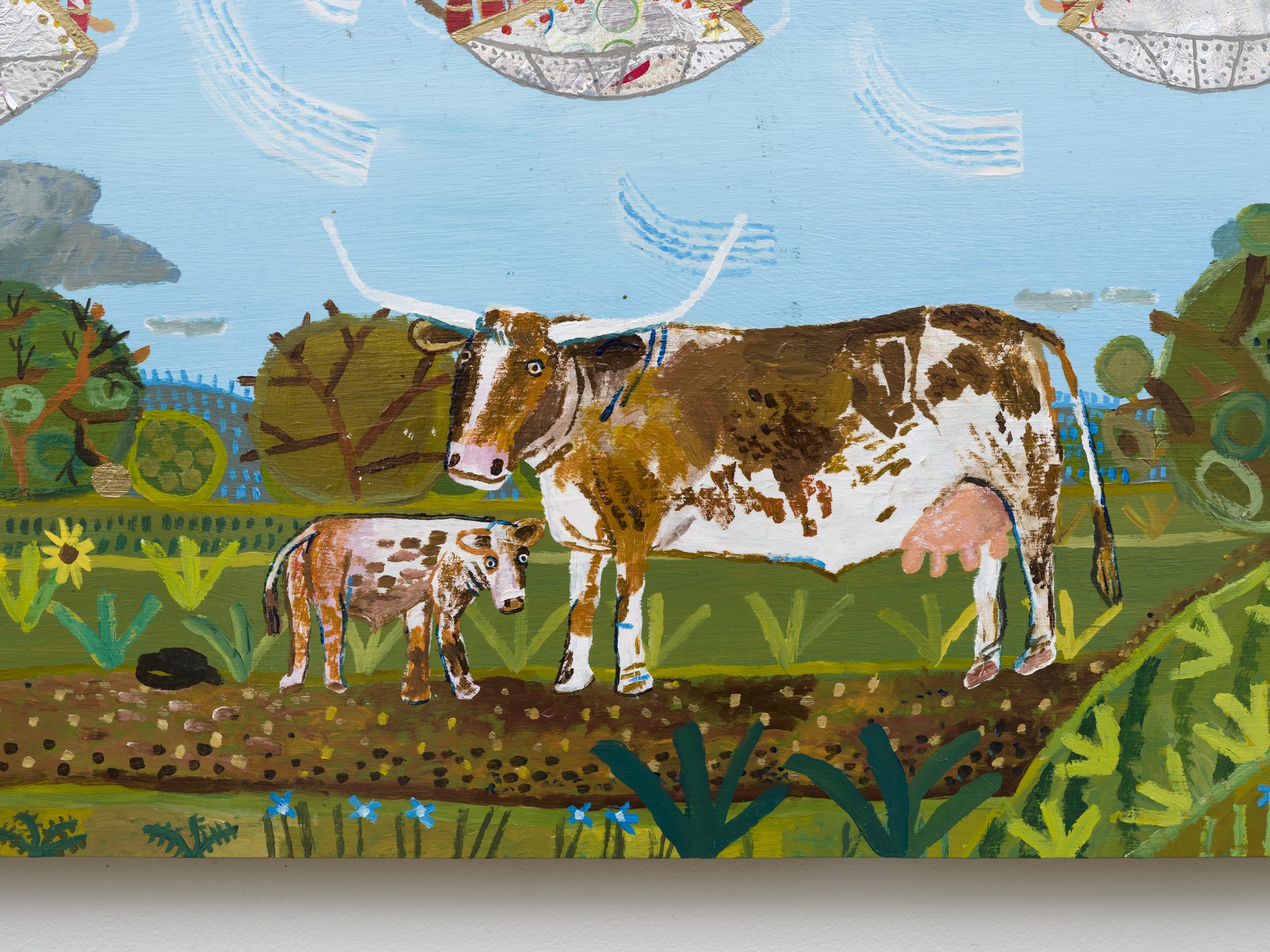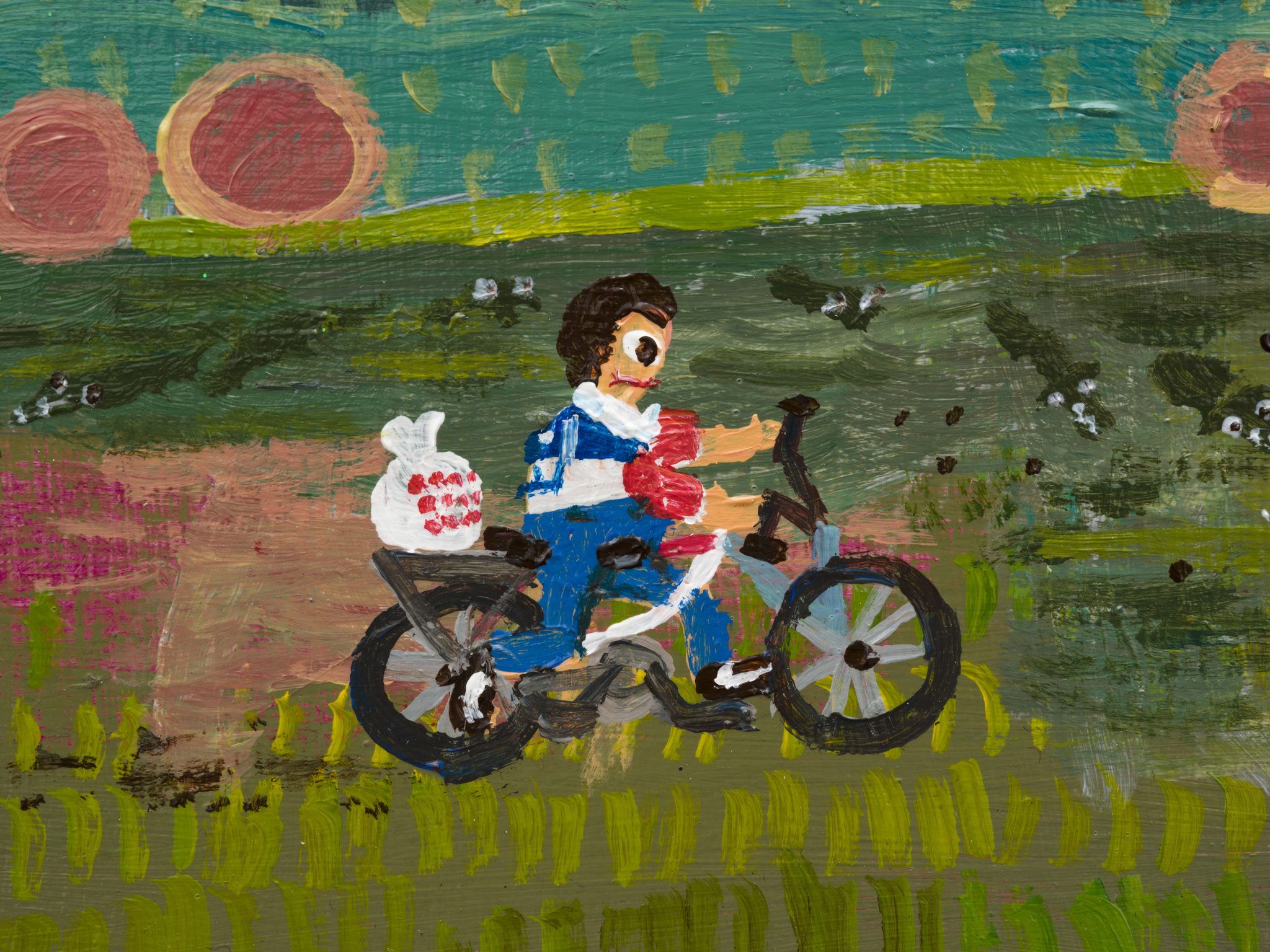

Installation image credit: Jeff McLane
Opening reception: Saturday, March 11, 4 – 6PM
Vielmetter Los Angeles is excited to present our third solo exhibition with Los Angeles based artist Esther Pearl Watson, “A Luminous Vision”, which will be on view in Gallery 3 from March 11 through April 22, 2023. Watson, known for her intimately detailed diaristic paintings, culls from her own memories and an archive of emails from family members transmuting her personal history of caregiving for her loved ones who struggle with their mental health into fantastical landscapes. Dappled with starry night skies, cascading comets, and sparkling UFOs, Watson’s memory paintings incorporate curious snippets of emails from her family members, contextualizing her compositions with an eccentric narrator. Of these works Watson describes her attempt to process the feeling of being grounded in reality whilst dealing with her family members’ mental states which can feel otherworldly. The exhibition shares a title with an immersive installation inspired by her father’s descriptions of his angelic companions’ tour through an interstellar landscape.
Text by art historian and author of “Queer Formalism: The Return,” William J. Simmons:
Beauty makes me hopeless. I don’t care why / anymore I just want to get away.
-Anne Carson, “On Hedonism”
Esther Pearl Watson’s medium is what is, and her medium is that which could be. It’s biblical in that way. She asks a question, lurking among statements of fact and fantasy: “Is the creation of earth a joke?” They say that if you want to make God laugh, tell him your plans.
One might also ask: Do you lie awake at night, thinking of the twinkling sky? Imagine that your dreams, the very wildest of them, have come true. You have all the money in the world, and you no longer have to buy Great Value brand products, with their chintzy whiteness that never sparkles, is never opalescent. The world is as it ought to be, as is your place within that world. Your feet are planted firmly on the ground, and your autobiography is no longer considered hysterical or self-indulgent or tragic. Do you no longer wish to get away? Do you look straight ahead, instead of upward? Is life, a normative life, enough for you, or does a dream come true still resemble a nightmare?
Yet Watson is never this maudlin. Her penchant for narrative can be both devastating and tongue-in-cheek. She reminds me of the Pre-Raphaelites, who also wanted to hop on a spaceship destined for elsewhere (Heaven). The pathos of, say, John Everett Millais’s painting Ophelia (1851-1852) lies not in the power of the Shakespearean story it references, but in its cringey investment in allegory and its feminized seriousness. Ophelia floats away, perhaps about to be probed, and we weep self-consciously and bathetically. Indeed, we probe ourselves, swiping tears away, from side to side, like the lone, horizontal cyclist in Watson’s We need to Build underground shelters on the Moon (2023).
Moreover, 19th century painting was often influenced by literature, and we could say that the Pre-Raphaelites, so invested in painterly retellings of poetry and myth, could be categorized as conceptual artists using art and text. The same could be said for Watson, whose interest in semiotics is frequently minimized as a mere reference to a folk vernacular. Writing what you mean without the opacity lent by criticality or the pretentiousness of memoir is difficult and necessary. It is a solitary venture. Painting and writing for God’s enjoyment, as the Pre-Raphaelites did, or for the enjoyment of little green men, is an act of faith that your shouts in the wilderness are received by somebody, somewhere, miraculously, like a letter to a lover whose only address you know is one you shared many, many years ago. You might only know the city and state, planet and galaxy, the antecedent but not the referent. There is so much space between images, words, and bodies, and they are crossed out from time to time, as with Watson’s earnest scrawls.
Perhaps the solitary figure in We need to Build underground shelters on the Moon has crossed himself out, absented himself from society in favor of the dreams offered by distant worlds. He will go up in smoke, like the cyclopes of a Philip Guston painting, and he longs to disintegrate into pigment, because it is easier than being flesh. This world might just be too hard for delicate people, a truth we find empathetically reinforced in Watson’s work.
Biography
Esther Pearl Watson (b. 1973) lives and works in Los Angeles. She received her MFA from California Institute of the Arts. Her paintings have been exhibited at McEvoy Family Collection, SF, CA; Richmond Center for Visual Arts, Kalamazoo, MI; Andrew Edlin Gallery, NY, NY; Concord Center for the Visual Arts, Concord, MA; Contemporary Art Museum of Plainview, Plainview, TX; University of Wisconsin-Parkside, Parkside, WI; Maureen Paley Gallery in London, and the Amon Carter Museum of American Art, Fort Worth, Texas, USA, amongst others. In 2013 she was Artist-in-Residence at Grafikiens Hus, Mariefred, Sweden. Her award-winning comic “Unlovable” was published in Bust Magazine and with Fantagraphics. She has published Blood Lady Commandos on Vice online and Welcome to Crapland on Adult Swim online. She has taught at Oxbow Artist Residency, the Lexicon of Sexicana at Columbia College in Chicago, and is currently teaching at ArtCenter College of Design, Pasadena, California.
“Adult angels from advanced civilizations,” 2023
Acrylic, graphite, glitter on canvas
40" x 60" [HxW] (101.6 x 152.4 cm)
Inventory #EPW471
Courtesy of the artist and Vielmetter Los Angeles
Photo credit: Jeff McLane
Signed and dated verso

“Adult angels from advanced civilizations,” 2023
Acrylic, graphite, glitter on canvas
40" x 60" [HxW] (101.6 x 152.4 cm)
Inventory #EPW471
Courtesy of the artist and Vielmetter Los Angeles
Photo credit: Jeff McLane
Signed and dated verso
“Adult angels from advanced civilizations,” 2023
Acrylic, graphite, glitter on canvas
40" x 60" [HxW] (101.6 x 152.4 cm)
Inventory #EPW471
Courtesy of the artist and Vielmetter Los Angeles
Photo credit: Jeff McLane
Signed and dated verso
“Adult angels from advanced civilizations,” 2023
Acrylic, graphite, glitter on canvas
40" x 60" [HxW] (101.6 x 152.4 cm)
Inventory #EPW471
Courtesy of the artist and Vielmetter Los Angeles
Photo credit: Jeff McLane
Signed and dated verso
“Adult angels from advanced civilizations,” 2023
Acrylic, graphite, glitter on canvas
40" x 60" [HxW] (101.6 x 152.4 cm)
Inventory #EPW471
Courtesy of the artist and Vielmetter Los Angeles
Photo credit: Jeff McLane
Signed and dated verso
“Adult angels from advanced civilizations,” 2023
Acrylic, graphite, glitter on canvas
40" x 60" [HxW] (101.6 x 152.4 cm)
Inventory #EPW471
Courtesy of the artist and Vielmetter Los Angeles
Photo credit: Jeff McLane
Signed and dated verso
“Did you get this message?,” 2023
Acrylic, graphite, glitter on canvas
40" x 60" [HxW] (101.6 x 152.4 cm)
Inventory #EPW470
Courtesy of the artist and Vielmetter Los Angeles
Photo credit: Jeff McLane
Signed and dated verso

“Did you get this message?,” 2023
Acrylic, graphite, glitter on canvas
40" x 60" [HxW] (101.6 x 152.4 cm)
Inventory #EPW470
Courtesy of the artist and Vielmetter Los Angeles
Photo credit: Jeff McLane
Signed and dated verso
“Did you get this message?,” 2023
Acrylic, graphite, glitter on canvas
40" x 60" [HxW] (101.6 x 152.4 cm)
Inventory #EPW470
Courtesy of the artist and Vielmetter Los Angeles
Photo credit: Jeff McLane
Signed and dated verso
“Did you get this message?,” 2023
Acrylic, graphite, glitter on canvas
40" x 60" [HxW] (101.6 x 152.4 cm)
Inventory #EPW470
Courtesy of the artist and Vielmetter Los Angeles
Photo credit: Jeff McLane
Signed and dated verso
“Did you get this message?,” 2023
Acrylic, graphite, glitter on canvas
40" x 60" [HxW] (101.6 x 152.4 cm)
Inventory #EPW470
Courtesy of the artist and Vielmetter Los Angeles
Photo credit: Jeff McLane
Signed and dated verso
“Did you get this message?,” 2023
Acrylic, graphite, glitter on canvas
40" x 60" [HxW] (101.6 x 152.4 cm)
Inventory #EPW470
Courtesy of the artist and Vielmetter Los Angeles
Photo credit: Jeff McLane
Signed and dated verso
“The Comet's Apparition,” 2023
Acrylic, graphite, glitter on canvas
6" x 6" [HxW] (15.24 x 15.24 cm)
Inventory #EPW498
Courtesy of the artist and Vielmetter Los Angeles
Photo credit: Jeff McLane
Signed and dated verso

“The Comet's Apparition,” 2023
Acrylic, graphite, glitter on canvas
6" x 6" [HxW] (15.24 x 15.24 cm)
Inventory #EPW498
Courtesy of the artist and Vielmetter Los Angeles
Photo credit: Jeff McLane
Signed and dated verso
“The Comet's Apparition,” 2023
Acrylic, graphite, glitter on canvas
6" x 6" [HxW] (15.24 x 15.24 cm)
Inventory #EPW498
Courtesy of the artist and Vielmetter Los Angeles
Photo credit: Jeff McLane
Signed and dated verso
“The Comet's Apparition,” 2023
Acrylic, graphite, glitter on canvas
6" x 6" [HxW] (15.24 x 15.24 cm)
Inventory #EPW498
Courtesy of the artist and Vielmetter Los Angeles
Photo credit: Jeff McLane
Signed and dated verso
“This radio frequency has already drifted into the past,” 2023
Acrylic, graphite, glitter on canvas
40" x 60" [HxW] (101.6 x 152.4 cm)
Inventory #EPW472
Courtesy of the artist and Vielmetter Los Angeles
Photo credit: Jeff McLane
Signed and dated verso

“This radio frequency has already drifted into the past,” 2023
Acrylic, graphite, glitter on canvas
40" x 60" [HxW] (101.6 x 152.4 cm)
Inventory #EPW472
Courtesy of the artist and Vielmetter Los Angeles
Photo credit: Jeff McLane
Signed and dated verso
“This radio frequency has already drifted into the past,” 2023
Acrylic, graphite, glitter on canvas
40" x 60" [HxW] (101.6 x 152.4 cm)
Inventory #EPW472
Courtesy of the artist and Vielmetter Los Angeles
Photo credit: Jeff McLane
Signed and dated verso
“This radio frequency has already drifted into the past,” 2023
Acrylic, graphite, glitter on canvas
40" x 60" [HxW] (101.6 x 152.4 cm)
Inventory #EPW472
Courtesy of the artist and Vielmetter Los Angeles
Photo credit: Jeff McLane
Signed and dated verso
“This radio frequency has already drifted into the past,” 2023
Acrylic, graphite, glitter on canvas
40" x 60" [HxW] (101.6 x 152.4 cm)
Inventory #EPW472
Courtesy of the artist and Vielmetter Los Angeles
Photo credit: Jeff McLane
Signed and dated verso
“This radio frequency has already drifted into the past,” 2023
Acrylic, graphite, glitter on canvas
40" x 60" [HxW] (101.6 x 152.4 cm)
Inventory #EPW472
Courtesy of the artist and Vielmetter Los Angeles
Photo credit: Jeff McLane
Signed and dated verso
“Walking Each Other Home,” 2023
Acrylic, graphite, glitter on canvas
24" x 18" x 1 ¹⁄₂" [HxWxD] (60.96 x 45.72 x 3.81 cm)
Inventory #EPW475
Courtesy of the artist and Vielmetter Los Angeles
Photo credit: Jeff McLane
Signed and dated

“Walking Each Other Home,” 2023
Acrylic, graphite, glitter on canvas
24" x 18" x 1 ¹⁄₂" [HxWxD] (60.96 x 45.72 x 3.81 cm)
Inventory #EPW475
Courtesy of the artist and Vielmetter Los Angeles
Photo credit: Jeff McLane
Signed and dated
“Walking Each Other Home,” 2023
Acrylic, graphite, glitter on canvas
24" x 18" x 1 ¹⁄₂" [HxWxD] (60.96 x 45.72 x 3.81 cm)
Inventory #EPW475
Courtesy of the artist and Vielmetter Los Angeles
Photo credit: Jeff McLane
Signed and dated
“Walking Each Other Home,” 2023
Acrylic, graphite, glitter on canvas
24" x 18" x 1 ¹⁄₂" [HxWxD] (60.96 x 45.72 x 3.81 cm)
Inventory #EPW475
Courtesy of the artist and Vielmetter Los Angeles
Photo credit: Jeff McLane
Signed and dated
“Walking Each Other Home,” 2023
Acrylic, graphite, glitter on canvas
24" x 18" x 1 ¹⁄₂" [HxWxD] (60.96 x 45.72 x 3.81 cm)
Inventory #EPW475
Courtesy of the artist and Vielmetter Los Angeles
Photo credit: Jeff McLane
Signed and dated
“Walking Each Other Home,” 2023
Acrylic, graphite, glitter on canvas
24" x 18" x 1 ¹⁄₂" [HxWxD] (60.96 x 45.72 x 3.81 cm)
Inventory #EPW475
Courtesy of the artist and Vielmetter Los Angeles
Photo credit: Jeff McLane
Signed and dated
“Do I Annoy You with my Positivity?,” 2023
Acrylic and mixed media on panel
60" x 60" [HxW] (152.4 x 152.4 cm)
Inventory #EPW507
Courtesy of the artist and Vielmetter Los Angeles
Photo credit: Brica Wilcox
Signed and dated verso

“Do I Annoy You with my Positivity?,” 2023
Acrylic and mixed media on panel
60" x 60" [HxW] (152.4 x 152.4 cm)
Inventory #EPW507
Courtesy of the artist and Vielmetter Los Angeles
Photo credit: Brica Wilcox
Signed and dated verso
“Do I Annoy You with my Positivity?,” 2023
Acrylic and mixed media on panel
60" x 60" [HxW] (152.4 x 152.4 cm)
Inventory #EPW507
Courtesy of the artist and Vielmetter Los Angeles
Photo credit: Brica Wilcox
Signed and dated verso
“Do I Annoy You with my Positivity?,” 2023
Acrylic and mixed media on panel
60" x 60" [HxW] (152.4 x 152.4 cm)
Inventory #EPW507
Courtesy of the artist and Vielmetter Los Angeles
Photo credit: Brica Wilcox
Signed and dated verso
“Do I Annoy You with my Positivity?,” 2023
Acrylic and mixed media on panel
60" x 60" [HxW] (152.4 x 152.4 cm)
Inventory #EPW507
Courtesy of the artist and Vielmetter Los Angeles
Photo credit: Brica Wilcox
Signed and dated verso
“Just Passing Through a Magnetic Field,” 2023
Acrylic, graphite, glitter on canvas
60" x 60" [HxW] (152.4 x 152.4 cm)
Inventory #EPW473
Courtesy of the artist and Vielmetter Los Angeles
Photo credit: Brica Wilcox

“Just Passing Through a Magnetic Field,” 2023
Acrylic, graphite, glitter on canvas
60" x 60" [HxW] (152.4 x 152.4 cm)
Inventory #EPW473
Courtesy of the artist and Vielmetter Los Angeles
Photo credit: Brica Wilcox
“Just Passing Through a Magnetic Field,” 2023
Acrylic, graphite, glitter on canvas
60" x 60" [HxW] (152.4 x 152.4 cm)
Inventory #EPW473
Courtesy of the artist and Vielmetter Los Angeles
Photo credit: Brica Wilcox
“Just Passing Through a Magnetic Field,” 2023
Acrylic, graphite, glitter on canvas
60" x 60" [HxW] (152.4 x 152.4 cm)
Inventory #EPW473
Courtesy of the artist and Vielmetter Los Angeles
Photo credit: Brica Wilcox
“Just Passing Through a Magnetic Field,” 2023
Acrylic, graphite, glitter on canvas
60" x 60" [HxW] (152.4 x 152.4 cm)
Inventory #EPW473
Courtesy of the artist and Vielmetter Los Angeles
Photo credit: Brica Wilcox
“Just Passing Through a Magnetic Field,” 2023
Acrylic, graphite, glitter on canvas
60" x 60" [HxW] (152.4 x 152.4 cm)
Inventory #EPW473
Courtesy of the artist and Vielmetter Los Angeles
Photo credit: Brica Wilcox
“Nebulocity of Interstellar Gas and Dust,” 2023
Acrylic and mixed media on panel
24" x 18" x 2" [HxWxD] (60.96 x 45.72 x 5.08 cm)
Inventory #EPW506
Courtesy of the artist and Vielmetter Los Angeles
Photo credit: Brica Wilcox

“Nebulocity of Interstellar Gas and Dust,” 2023
Acrylic and mixed media on panel
24" x 18" x 2" [HxWxD] (60.96 x 45.72 x 5.08 cm)
Inventory #EPW506
Courtesy of the artist and Vielmetter Los Angeles
Photo credit: Brica Wilcox
“Nebulocity of Interstellar Gas and Dust,” 2023
Acrylic and mixed media on panel
24" x 18" x 2" [HxWxD] (60.96 x 45.72 x 5.08 cm)
Inventory #EPW506
Courtesy of the artist and Vielmetter Los Angeles
Photo credit: Brica Wilcox
“Nebulocity of Interstellar Gas and Dust,” 2023
Acrylic and mixed media on panel
24" x 18" x 2" [HxWxD] (60.96 x 45.72 x 5.08 cm)
Inventory #EPW506
Courtesy of the artist and Vielmetter Los Angeles
Photo credit: Brica Wilcox
“The Goldi Lox Zone,” 2023
Acrylic and mixed media on panel
60" x 40" [HxW] (152.4 x 101.6 cm)
Inventory #EPW505
Courtesy of the artist and Vielmetter Los Angeles
Photo credit: Brica Wilcox
Signed and dated verso

“The Goldi Lox Zone,” 2023
Acrylic and mixed media on panel
60" x 40" [HxW] (152.4 x 101.6 cm)
Inventory #EPW505
Courtesy of the artist and Vielmetter Los Angeles
Photo credit: Brica Wilcox
Signed and dated verso
“The Goldi Lox Zone,” 2023
Acrylic and mixed media on panel
60" x 40" [HxW] (152.4 x 101.6 cm)
Inventory #EPW505
Courtesy of the artist and Vielmetter Los Angeles
Photo credit: Brica Wilcox
Signed and dated verso
“The Goldi Lox Zone,” 2023
Acrylic and mixed media on panel
60" x 40" [HxW] (152.4 x 101.6 cm)
Inventory #EPW505
Courtesy of the artist and Vielmetter Los Angeles
Photo credit: Brica Wilcox
Signed and dated verso
“The Goldi Lox Zone,” 2023
Acrylic and mixed media on panel
60" x 40" [HxW] (152.4 x 101.6 cm)
Inventory #EPW505
Courtesy of the artist and Vielmetter Los Angeles
Photo credit: Brica Wilcox
Signed and dated verso
“The Angelic Inspection,” 2023
Acrylic and mixed media on panel
60" x 40" [HxW] (152.4 x 101.6 cm)
Inventory #EPW504
Courtesy of the artist and Vielmetter Los Angeles
Photo credit: Brica Wilcox
Signed and dated verso

“The Angelic Inspection,” 2023
Acrylic and mixed media on panel
60" x 40" [HxW] (152.4 x 101.6 cm)
Inventory #EPW504
Courtesy of the artist and Vielmetter Los Angeles
Photo credit: Brica Wilcox
Signed and dated verso
“The Angelic Inspection,” 2023
Acrylic and mixed media on panel
60" x 40" [HxW] (152.4 x 101.6 cm)
Inventory #EPW504
Courtesy of the artist and Vielmetter Los Angeles
Photo credit: Brica Wilcox
Signed and dated verso
“The Angelic Inspection,” 2023
Acrylic and mixed media on panel
60" x 40" [HxW] (152.4 x 101.6 cm)
Inventory #EPW504
Courtesy of the artist and Vielmetter Los Angeles
Photo credit: Brica Wilcox
Signed and dated verso
“The Angelic Inspection,” 2023
Acrylic and mixed media on panel
60" x 40" [HxW] (152.4 x 101.6 cm)
Inventory #EPW504
Courtesy of the artist and Vielmetter Los Angeles
Photo credit: Brica Wilcox
Signed and dated verso
“The Angelic Inspection,” 2023
Acrylic and mixed media on panel
60" x 40" [HxW] (152.4 x 101.6 cm)
Inventory #EPW504
Courtesy of the artist and Vielmetter Los Angeles
Photo credit: Brica Wilcox
Signed and dated verso
“Artificial Intellegence Automatically Substitutes My Words,” 2022
Acrylic, gouache, foil, pencil on paper
7 ³⁄₄" x 6" [HxW] (19.69 x 15.24 cm); 10 ³⁄₄" x 8 ³⁄₄" x 1" [HxWxD] (27.3 x 22.22 x 2.54 cm) Framed
Inventory #EPW491
Courtesy of the artist and Vielmetter Los Angeles
Photo credit: Brica Wilcox
Signed and dated recto

“Artificial Intellegence Automatically Substitutes My Words,” 2022
Acrylic, gouache, foil, pencil on paper
7 ³⁄₄" x 6" [HxW] (19.69 x 15.24 cm); 10 ³⁄₄" x 8 ³⁄₄" x 1" [HxWxD] (27.3 x 22.22 x 2.54 cm) Framed
Inventory #EPW491
Courtesy of the artist and Vielmetter Los Angeles
Photo credit: Brica Wilcox
Signed and dated recto
“The Goldi Lox Zone,” 2022
Acrylic, gouache, foil, pencil on paper
7 ³⁄₄" x 6" [HxW] (19.69 x 15.24 cm); 10 ³⁄₄" x 8 ³⁄₄" x 1" [HxWxD] (27.3 x 22.22 x 2.54 cm) Framed
Inventory #EPW490
Courtesy of the artist and Vielmetter Los Angeles
Photo credit: Brica Wilcox
Signed and dated recto

“The Goldi Lox Zone,” 2022
Acrylic, gouache, foil, pencil on paper
7 ³⁄₄" x 6" [HxW] (19.69 x 15.24 cm); 10 ³⁄₄" x 8 ³⁄₄" x 1" [HxWxD] (27.3 x 22.22 x 2.54 cm) Framed
Inventory #EPW490
Courtesy of the artist and Vielmetter Los Angeles
Photo credit: Brica Wilcox
Signed and dated recto
“Graves Should Be Gives,” 2022
Acrylic, gouache, foil, pencil on paper
7 ³⁄₄" x 6" [HxW] (19.69 x 15.24 cm); 10 ³⁄₄" x 8 ³⁄₄" x 1" [HxWxD] (27.3 x 22.22 x 2.54 cm) framed
Inventory #EPW487
Courtesy of the artist and Vielmetter Los Angeles
Photo credit: Brica Wilcox
Signed and dated recto

“Graves Should Be Gives,” 2022
Acrylic, gouache, foil, pencil on paper
7 ³⁄₄" x 6" [HxW] (19.69 x 15.24 cm); 10 ³⁄₄" x 8 ³⁄₄" x 1" [HxWxD] (27.3 x 22.22 x 2.54 cm) framed
Inventory #EPW487
Courtesy of the artist and Vielmetter Los Angeles
Photo credit: Brica Wilcox
Signed and dated recto
“Dust Clouds Around the Perimeter of the Galaxy,” 2022
Acrylic, gouache, foil, pencil on paper
7 ³⁄₄" x 6" [HxW] (19.69 x 15.24 cm); 10 ³⁄₄" x 8 ³⁄₄" x 1" [HxWxD] (27.3 x 22.22 x 2.54 cm) Framed
Inventory #EPW489
Courtesy of the artist and Vielmetter Los Angeles
Photo credit: Brica Wilcox
Signed and dated recto

“Dust Clouds Around the Perimeter of the Galaxy,” 2022
Acrylic, gouache, foil, pencil on paper
7 ³⁄₄" x 6" [HxW] (19.69 x 15.24 cm); 10 ³⁄₄" x 8 ³⁄₄" x 1" [HxWxD] (27.3 x 22.22 x 2.54 cm) Framed
Inventory #EPW489
Courtesy of the artist and Vielmetter Los Angeles
Photo credit: Brica Wilcox
Signed and dated recto
“Nature Forces Man to be Angelic,” 2022
Acrylic, gouache, foil, pencil on paper
7 ³⁄₄" x 6" [HxW] (19.69 x 15.24 cm); 10 ³⁄₄" x 8 ³⁄₄" x 1" [HxWxD] (27.3 x 22.22 x 2.54 cm) Framed
Inventory #EPW486
Courtesy of the artist and Vielmetter Los Angeles
Photo credit: Brica Wilcox
Signed and dated recto

“Nature Forces Man to be Angelic,” 2022
Acrylic, gouache, foil, pencil on paper
7 ³⁄₄" x 6" [HxW] (19.69 x 15.24 cm); 10 ³⁄₄" x 8 ³⁄₄" x 1" [HxWxD] (27.3 x 22.22 x 2.54 cm) Framed
Inventory #EPW486
Courtesy of the artist and Vielmetter Los Angeles
Photo credit: Brica Wilcox
Signed and dated recto
“A Full Gegetarian Variety for Everyone,” 2022
Acrylic, gouache, foil, pencil on paper
7 ³⁄₄" x 6" [HxW] (19.69 x 15.24 cm); 10 ³⁄₄" x 8 ³⁄₄" x 1" [HxWxD] (27.3 x 22.22 x 2.54 cm) Framed
Inventory #EPW488
Courtesy of the artist and Vielmetter Los Angeles
Photo credit: Brica Wilcox
Signed and dated recto

“A Full Gegetarian Variety for Everyone,” 2022
Acrylic, gouache, foil, pencil on paper
7 ³⁄₄" x 6" [HxW] (19.69 x 15.24 cm); 10 ³⁄₄" x 8 ³⁄₄" x 1" [HxWxD] (27.3 x 22.22 x 2.54 cm) Framed
Inventory #EPW488
Courtesy of the artist and Vielmetter Los Angeles
Photo credit: Brica Wilcox
Signed and dated recto
“Twin Torrid Storage Chambers,” 2022
Pencil, vinyl on paper
4 ³⁄₄" x 5 ³⁄₄" [HxW] (12.07 x 14.61 cm); 7 ¹⁄₂" x 8 ³⁄₄" x 1" [HxWxD] (19.05 x 22.22 x 2.54 cm)
Inventory #EPW483
Courtesy of the artist and Vielmetter Los Angeles
Photo credit: Brica Wilcox
Signed and dated recto

“Twin Torrid Storage Chambers,” 2022
Pencil, vinyl on paper
4 ³⁄₄" x 5 ³⁄₄" [HxW] (12.07 x 14.61 cm); 7 ¹⁄₂" x 8 ³⁄₄" x 1" [HxWxD] (19.05 x 22.22 x 2.54 cm)
Inventory #EPW483
Courtesy of the artist and Vielmetter Los Angeles
Photo credit: Brica Wilcox
Signed and dated recto
“Causes Both Motors to Repel Ions,” 2022
Pencil, vinyl on paper
4" x 6 ¹⁄₂" [HxW] (10.16 x 16.51 cm); 6 ³⁄₄" x 9 ¹⁄₄" x 1" [HxWxD] (17.14 x 23.49 x 2.54 cm) Framed
Inventory #EPW485
Courtesy of the artist and Vielmetter Los Angeles
Photo credit: Brica Wilcox
Signed and dated recto

“Causes Both Motors to Repel Ions,” 2022
Pencil, vinyl on paper
4" x 6 ¹⁄₂" [HxW] (10.16 x 16.51 cm); 6 ³⁄₄" x 9 ¹⁄₄" x 1" [HxWxD] (17.14 x 23.49 x 2.54 cm) Framed
Inventory #EPW485
Courtesy of the artist and Vielmetter Los Angeles
Photo credit: Brica Wilcox
Signed and dated recto
“Dry exhalation of earth,” 2023
Acrylic, graphite, glitter on canvas
6" x 6" [HxW] (15.24 x 15.24 cm)
Inventory #EPW502
Courtesy of the artist and Vielmetter Los Angeles
Photo credit: Jeff McLane
Signed and dated verso

“Dry exhalation of earth,” 2023
Acrylic, graphite, glitter on canvas
6" x 6" [HxW] (15.24 x 15.24 cm)
Inventory #EPW502
Courtesy of the artist and Vielmetter Los Angeles
Photo credit: Jeff McLane
Signed and dated verso
“Dry exhalation of earth,” 2023
Acrylic, graphite, glitter on canvas
6" x 6" [HxW] (15.24 x 15.24 cm)
Inventory #EPW502
Courtesy of the artist and Vielmetter Los Angeles
Photo credit: Jeff McLane
Signed and dated verso
“Dry exhalation of earth,” 2023
Acrylic, graphite, glitter on canvas
6" x 6" [HxW] (15.24 x 15.24 cm)
Inventory #EPW502
Courtesy of the artist and Vielmetter Los Angeles
Photo credit: Jeff McLane
Signed and dated verso
“Electrons Diverted,” 2023
Acrylic and mixed media on panel
18" x 24" x 2" [HxWxD] (45.72 x 60.96 x 5.08 cm)
Inventory #EPW509
Courtesy of the artist and Vielmetter Los Angeles
Photo credit: Brica Wilcox

“Electrons Diverted,” 2023
Acrylic and mixed media on panel
18" x 24" x 2" [HxWxD] (45.72 x 60.96 x 5.08 cm)
Inventory #EPW509
Courtesy of the artist and Vielmetter Los Angeles
Photo credit: Brica Wilcox
“Electrons Diverted,” 2023
Acrylic and mixed media on panel
18" x 24" x 2" [HxWxD] (45.72 x 60.96 x 5.08 cm)
Inventory #EPW509
Courtesy of the artist and Vielmetter Los Angeles
Photo credit: Brica Wilcox
“Electrons Diverted,” 2023
Acrylic and mixed media on panel
18" x 24" x 2" [HxWxD] (45.72 x 60.96 x 5.08 cm)
Inventory #EPW509
Courtesy of the artist and Vielmetter Los Angeles
Photo credit: Brica Wilcox
“Employed to look out for comets,” 2023
Acrylic, graphite, glitter on canvas
6" x 6" [HxW] (15.24 x 15.24 cm)
Inventory #EPW499
Courtesy of the artist and Vielmetter Los Angeles
Photo credit: Jeff McLane
Signed and dated verso

“Employed to look out for comets,” 2023
Acrylic, graphite, glitter on canvas
6" x 6" [HxW] (15.24 x 15.24 cm)
Inventory #EPW499
Courtesy of the artist and Vielmetter Los Angeles
Photo credit: Jeff McLane
Signed and dated verso
“Employed to look out for comets,” 2023
Acrylic, graphite, glitter on canvas
6" x 6" [HxW] (15.24 x 15.24 cm)
Inventory #EPW499
Courtesy of the artist and Vielmetter Los Angeles
Photo credit: Jeff McLane
Signed and dated verso
“Employed to look out for comets,” 2023
Acrylic, graphite, glitter on canvas
6" x 6" [HxW] (15.24 x 15.24 cm)
Inventory #EPW499
Courtesy of the artist and Vielmetter Los Angeles
Photo credit: Jeff McLane
Signed and dated verso
“My Angelic Companion,” 2023
Acrylic, graphite, glitter on canvas
24" x 36" x 1" [HxWxD] (60.96 x 91.44 x 2.54 cm)
Inventory #EPW474
Courtesy of the artist and Vielmetter Los Angeles
Photo credit: Jeff McLane
Signed and dated

“My Angelic Companion,” 2023
Acrylic, graphite, glitter on canvas
24" x 36" x 1" [HxWxD] (60.96 x 91.44 x 2.54 cm)
Inventory #EPW474
Courtesy of the artist and Vielmetter Los Angeles
Photo credit: Jeff McLane
Signed and dated
“My Angelic Companion,” 2023
Acrylic, graphite, glitter on canvas
24" x 36" x 1" [HxWxD] (60.96 x 91.44 x 2.54 cm)
Inventory #EPW474
Courtesy of the artist and Vielmetter Los Angeles
Photo credit: Jeff McLane
Signed and dated
“My Angelic Companion,” 2023
Acrylic, graphite, glitter on canvas
24" x 36" x 1" [HxWxD] (60.96 x 91.44 x 2.54 cm)
Inventory #EPW474
Courtesy of the artist and Vielmetter Los Angeles
Photo credit: Jeff McLane
Signed and dated
“My Angelic Companion,” 2023
Acrylic, graphite, glitter on canvas
24" x 36" x 1" [HxWxD] (60.96 x 91.44 x 2.54 cm)
Inventory #EPW474
Courtesy of the artist and Vielmetter Los Angeles
Photo credit: Jeff McLane
Signed and dated
“My Angelic Companion,” 2023
Acrylic, graphite, glitter on canvas
24" x 36" x 1" [HxWxD] (60.96 x 91.44 x 2.54 cm)
Inventory #EPW474
Courtesy of the artist and Vielmetter Los Angeles
Photo credit: Jeff McLane
Signed and dated
“Hallucination Totally Nonexistent,” 2023
Acrylic and mixed media on panel
18" x 24" x 2" [HxWxD] (45.72 x 60.96 x 5.08 cm)
Inventory #EPW508
Courtesy of the artist and Vielmetter Los Angeles
Photo credit: Brica Wilcox

“Hallucination Totally Nonexistent,” 2023
Acrylic and mixed media on panel
18" x 24" x 2" [HxWxD] (45.72 x 60.96 x 5.08 cm)
Inventory #EPW508
Courtesy of the artist and Vielmetter Los Angeles
Photo credit: Brica Wilcox
“Hallucination Totally Nonexistent,” 2023
Acrylic and mixed media on panel
18" x 24" x 2" [HxWxD] (45.72 x 60.96 x 5.08 cm)
Inventory #EPW508
Courtesy of the artist and Vielmetter Los Angeles
Photo credit: Brica Wilcox
“Hallucination Totally Nonexistent,” 2023
Acrylic and mixed media on panel
18" x 24" x 2" [HxWxD] (45.72 x 60.96 x 5.08 cm)
Inventory #EPW508
Courtesy of the artist and Vielmetter Los Angeles
Photo credit: Brica Wilcox
“Can occure under delicate conditions,” 2023
Acrylic, graphite, glitter on canvas
6" x 6" [HxW] (15.24 x 15.24 cm)
Inventory #EPW500
Courtesy of the artist and Vielmetter Los Angeles
Photo credit: Jeff McLane
Signed and dated verso

“Can occure under delicate conditions,” 2023
Acrylic, graphite, glitter on canvas
6" x 6" [HxW] (15.24 x 15.24 cm)
Inventory #EPW500
Courtesy of the artist and Vielmetter Los Angeles
Photo credit: Jeff McLane
Signed and dated verso
“Can occure under delicate conditions,” 2023
Acrylic, graphite, glitter on canvas
6" x 6" [HxW] (15.24 x 15.24 cm)
Inventory #EPW500
Courtesy of the artist and Vielmetter Los Angeles
Photo credit: Jeff McLane
Signed and dated verso
“Can occure under delicate conditions,” 2023
Acrylic, graphite, glitter on canvas
6" x 6" [HxW] (15.24 x 15.24 cm)
Inventory #EPW500
Courtesy of the artist and Vielmetter Los Angeles
Photo credit: Jeff McLane
Signed and dated verso
“Particle Beam Deflection,” 2022
Pencil, glitter on paper
4 ³⁄₄" x 5 ³⁄₄" [HxW] (12.07 x 14.61 cm); 7 ¹⁄₂" x 8 ³⁄₄" x 1" [HxWxD] (19.05 x 22.22 x 2.54 cm) Framed
Inventory #EPW482
Courtesy of the artist and Vielmetter Los Angeles
Photo credit: Brica Wilcox
Signed and dated recto
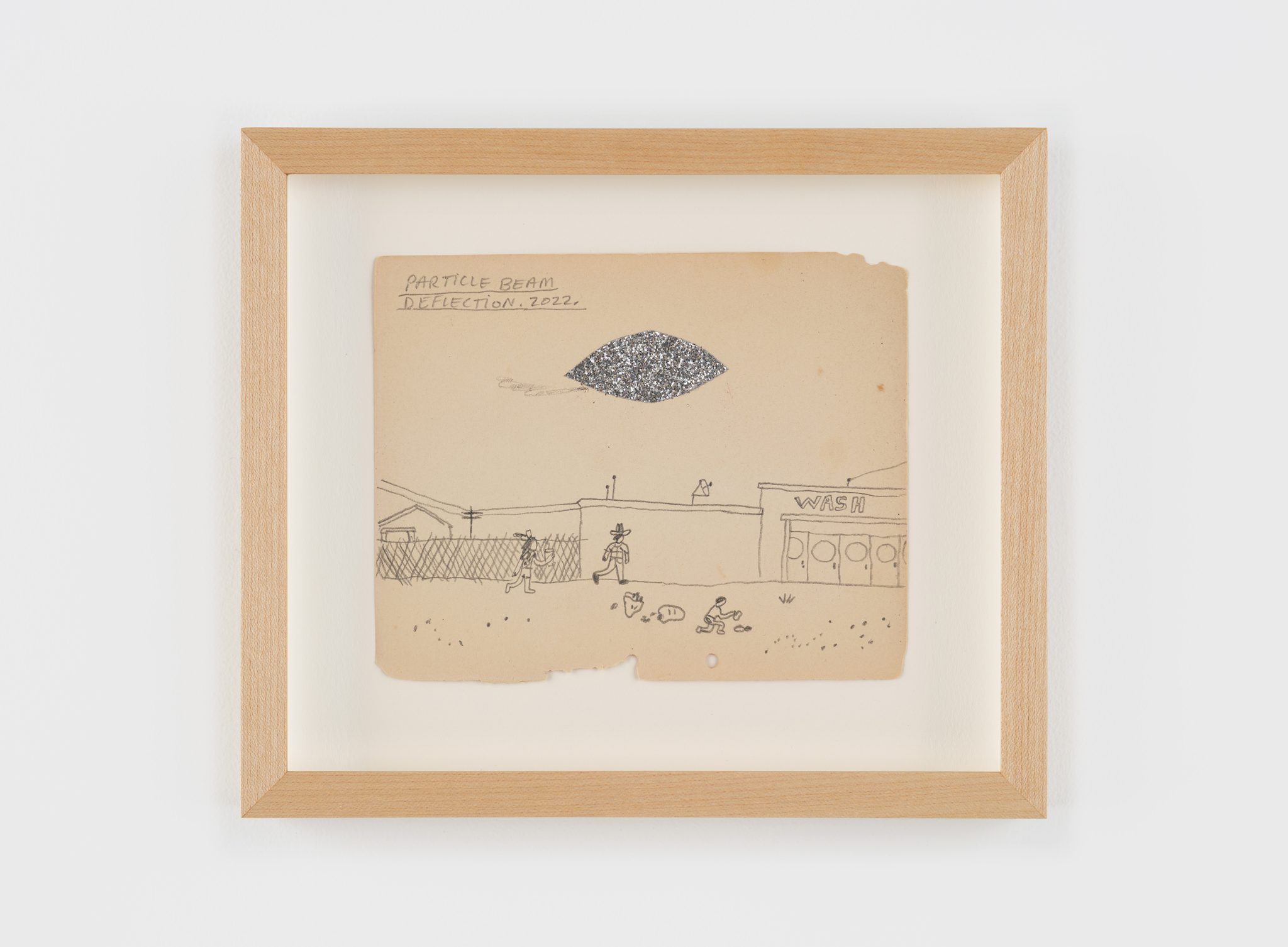
“Particle Beam Deflection,” 2022
Pencil, glitter on paper
4 ³⁄₄" x 5 ³⁄₄" [HxW] (12.07 x 14.61 cm); 7 ¹⁄₂" x 8 ³⁄₄" x 1" [HxWxD] (19.05 x 22.22 x 2.54 cm) Framed
Inventory #EPW482
Courtesy of the artist and Vielmetter Los Angeles
Photo credit: Brica Wilcox
Signed and dated recto
“This Would Cause Man to Fall in Love Instantly,” 2023
Graphite and foil on cardboard
8" x 10 ³⁄₄" [HxW] (20.32 x 27.31 cm); 11" x 13 ³⁄₄" x 1" [HxWxD] (27.94 x 34.92 x 2.54 cm) Framed
Inventory #EPW503
Courtesy of the artist and Vielmetter Los Angeles
Photo credit: Brica Wilcox

“This Would Cause Man to Fall in Love Instantly,” 2023
Graphite and foil on cardboard
8" x 10 ³⁄₄" [HxW] (20.32 x 27.31 cm); 11" x 13 ³⁄₄" x 1" [HxWxD] (27.94 x 34.92 x 2.54 cm) Framed
Inventory #EPW503
Courtesy of the artist and Vielmetter Los Angeles
Photo credit: Brica Wilcox
“We need to build underground shelters on the moon,” 2023
Acrylic, graphite, glitter on canvas
8" x 10" [HxW] (20.32 x 25.4 cm)
Inventory #EPW478
Courtesy of the artist and Vielmetter Los Angeles
Photo credit: Jeff McLane
Signed and dated verso

“We need to build underground shelters on the moon,” 2023
Acrylic, graphite, glitter on canvas
8" x 10" [HxW] (20.32 x 25.4 cm)
Inventory #EPW478
Courtesy of the artist and Vielmetter Los Angeles
Photo credit: Jeff McLane
Signed and dated verso
“We need to build underground shelters on the moon,” 2023
Acrylic, graphite, glitter on canvas
8" x 10" [HxW] (20.32 x 25.4 cm)
Inventory #EPW478
Courtesy of the artist and Vielmetter Los Angeles
Photo credit: Jeff McLane
Signed and dated verso
“We need to build underground shelters on the moon,” 2023
Acrylic, graphite, glitter on canvas
8" x 10" [HxW] (20.32 x 25.4 cm)
Inventory #EPW478
Courtesy of the artist and Vielmetter Los Angeles
Photo credit: Jeff McLane
Signed and dated verso
“Betelgeuse may have exploded centuries ago,” 2023
Acrylic, graphite, glitter on canvas
8" x 10" [HxW] (20.32 x 25.4 cm)
Inventory #EPW477
Courtesy of the artist and Vielmetter Los Angeles
Photo credit: Jeff McLane
Signed and dated verso

“Betelgeuse may have exploded centuries ago,” 2023
Acrylic, graphite, glitter on canvas
8" x 10" [HxW] (20.32 x 25.4 cm)
Inventory #EPW477
Courtesy of the artist and Vielmetter Los Angeles
Photo credit: Jeff McLane
Signed and dated verso
“Betelgeuse may have exploded centuries ago,” 2023
Acrylic, graphite, glitter on canvas
8" x 10" [HxW] (20.32 x 25.4 cm)
Inventory #EPW477
Courtesy of the artist and Vielmetter Los Angeles
Photo credit: Jeff McLane
Signed and dated verso
“Betelgeuse may have exploded centuries ago,” 2023
Acrylic, graphite, glitter on canvas
8" x 10" [HxW] (20.32 x 25.4 cm)
Inventory #EPW477
Courtesy of the artist and Vielmetter Los Angeles
Photo credit: Jeff McLane
Signed and dated verso
“Sachse, TX 1989,” 2023
Acrylic, graphite, glitter on canvas
9" x 12" [HxW] (22.86 x 30.48 cm)
Inventory #EPW476
Courtesy of the artist and Vielmetter Los Angeles
Photo credit: Jeff McLane
Signed and dated verso
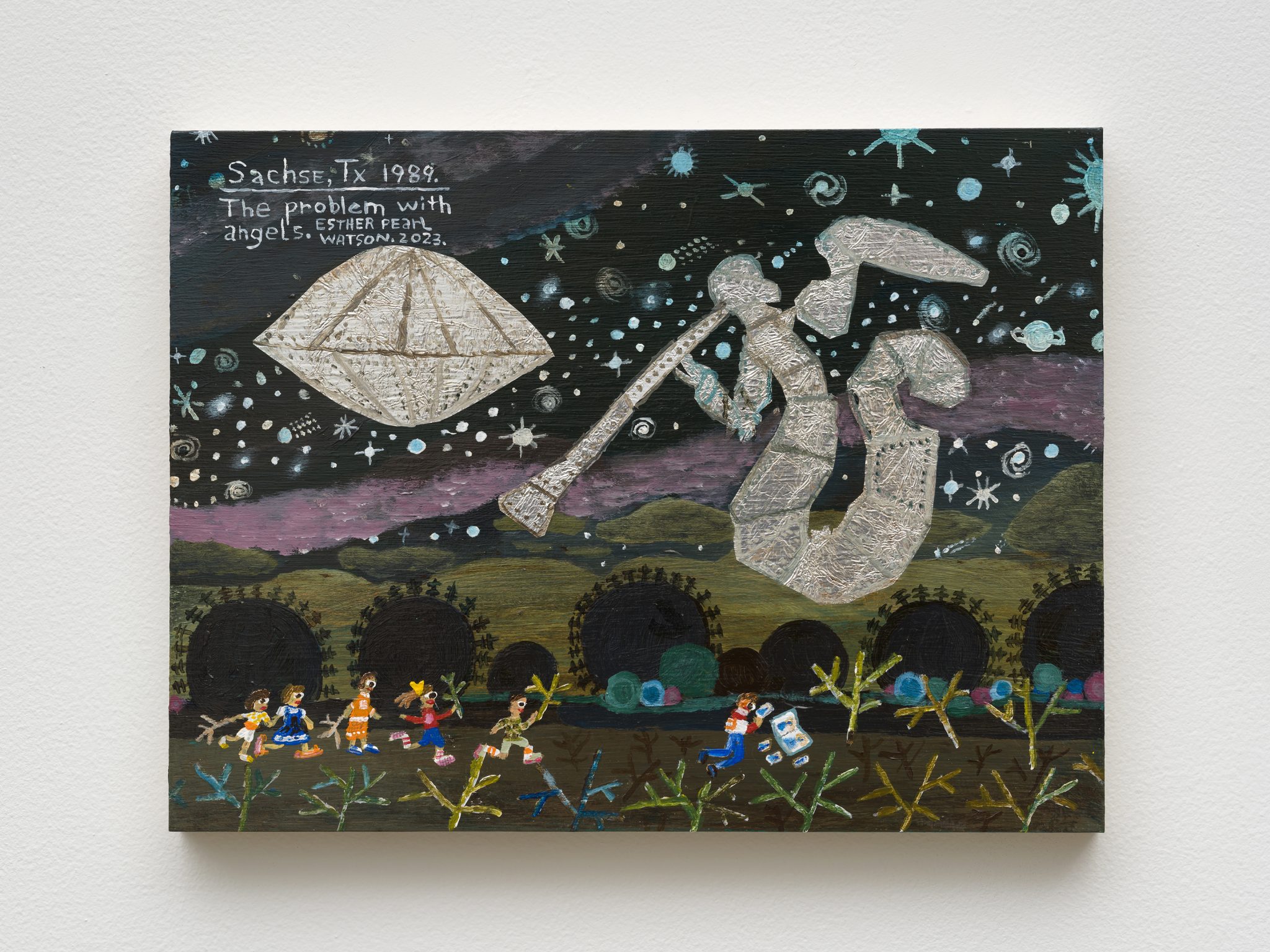
“Sachse, TX 1989,” 2023
Acrylic, graphite, glitter on canvas
9" x 12" [HxW] (22.86 x 30.48 cm)
Inventory #EPW476
Courtesy of the artist and Vielmetter Los Angeles
Photo credit: Jeff McLane
Signed and dated verso
“Sachse, TX 1989,” 2023
Acrylic, graphite, glitter on canvas
9" x 12" [HxW] (22.86 x 30.48 cm)
Inventory #EPW476
Courtesy of the artist and Vielmetter Los Angeles
Photo credit: Jeff McLane
Signed and dated verso
“Sachse, TX 1989,” 2023
Acrylic, graphite, glitter on canvas
9" x 12" [HxW] (22.86 x 30.48 cm)
Inventory #EPW476
Courtesy of the artist and Vielmetter Los Angeles
Photo credit: Jeff McLane
Signed and dated verso
“Interlocking chrystal structure,” 2023
Acrylic, graphite, glitter on canvas
6" x 6" [HxW] (15.24 x 15.24 cm)
Inventory #EPW501
Courtesy of the artist and Vielmetter Los Angeles
Photo credit: Jeff McLane
Signed and dated verso

“Interlocking chrystal structure,” 2023
Acrylic, graphite, glitter on canvas
6" x 6" [HxW] (15.24 x 15.24 cm)
Inventory #EPW501
Courtesy of the artist and Vielmetter Los Angeles
Photo credit: Jeff McLane
Signed and dated verso
“Interlocking chrystal structure,” 2023
Acrylic, graphite, glitter on canvas
6" x 6" [HxW] (15.24 x 15.24 cm)
Inventory #EPW501
Courtesy of the artist and Vielmetter Los Angeles
Photo credit: Jeff McLane
Signed and dated verso
“Interlocking chrystal structure,” 2023
Acrylic, graphite, glitter on canvas
6" x 6" [HxW] (15.24 x 15.24 cm)
Inventory #EPW501
Courtesy of the artist and Vielmetter Los Angeles
Photo credit: Jeff McLane
Signed and dated verso
“For Interplanetary Orbital,” 2022
Pencil, vinyl on paper
4 ³⁄₄" x 5 ³⁄₄" [HxW] (12.07 x 14.61 cm); 7 ¹⁄₂" x 8 ³⁄₄" x 1" [HxWxD] (19.05 x 22.22 x 2.54 cm) Framed
Inventory #EPW484
Courtesy of the artist and Vielmetter Los Angeles
Photo credit: Brica Wilcox
Signed and dated recto

“For Interplanetary Orbital,” 2022
Pencil, vinyl on paper
4 ³⁄₄" x 5 ³⁄₄" [HxW] (12.07 x 14.61 cm); 7 ¹⁄₂" x 8 ³⁄₄" x 1" [HxWxD] (19.05 x 22.22 x 2.54 cm) Framed
Inventory #EPW484
Courtesy of the artist and Vielmetter Los Angeles
Photo credit: Brica Wilcox
Signed and dated recto
“The Comet's Apparition,” 2023
Acrylic, graphite, glitter on canvas
6" x 6" [HxW] (15.24 x 15.24 cm)
Inventory #EPW498
Courtesy of the artist and Vielmetter Los Angeles
Photo credit: Jeff McLane
Signed and dated verso

“The Comet's Apparition,” 2023
Acrylic, graphite, glitter on canvas
6" x 6" [HxW] (15.24 x 15.24 cm)
Inventory #EPW498
Courtesy of the artist and Vielmetter Los Angeles
Photo credit: Jeff McLane
Signed and dated verso
“The Comet's Apparition,” 2023
Acrylic, graphite, glitter on canvas
6" x 6" [HxW] (15.24 x 15.24 cm)
Inventory #EPW498
Courtesy of the artist and Vielmetter Los Angeles
Photo credit: Jeff McLane
Signed and dated verso
“The Comet's Apparition,” 2023
Acrylic, graphite, glitter on canvas
6" x 6" [HxW] (15.24 x 15.24 cm)
Inventory #EPW498
Courtesy of the artist and Vielmetter Los Angeles
Photo credit: Jeff McLane
Signed and dated verso
“This Is the Best Cure for Anything,” 2023
Pencil, foil on paper
14 ¹⁄₂" x 19 ¹⁄₂" [HxW] (36.83 x 49.53 cm); 18 ¹⁄₂" x 23 ¹⁄₄" x 1" [HxWxD] (46.99 x 59.05 x 2.54 cm) Framed
Inventory #EPW480
Courtesy of the artist and Vielmetter Los Angeles
Photo credit: Brica Wilcox
Signed and dated recto
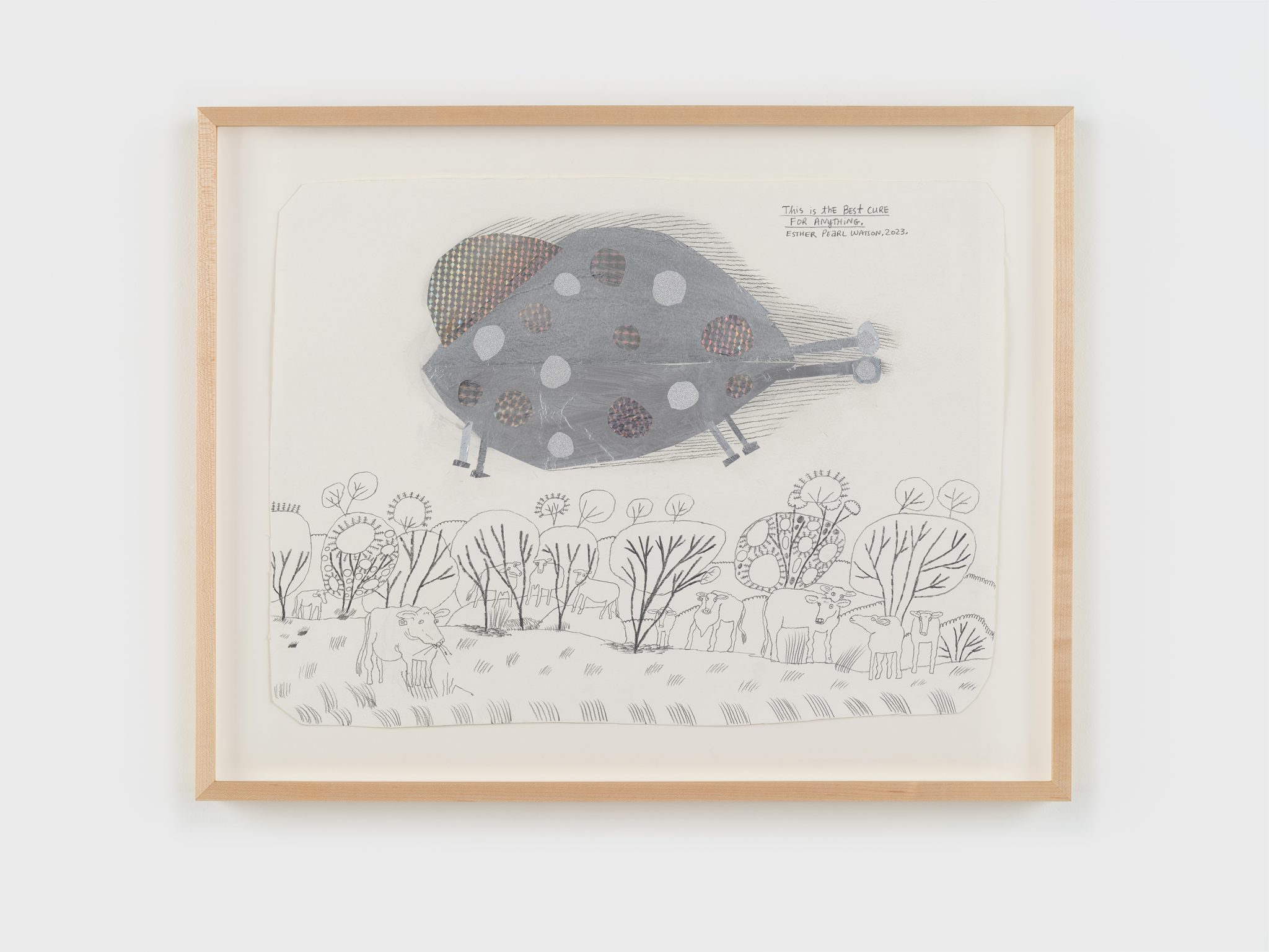
“This Is the Best Cure for Anything,” 2023
Pencil, foil on paper
14 ¹⁄₂" x 19 ¹⁄₂" [HxW] (36.83 x 49.53 cm); 18 ¹⁄₂" x 23 ¹⁄₄" x 1" [HxWxD] (46.99 x 59.05 x 2.54 cm) Framed
Inventory #EPW480
Courtesy of the artist and Vielmetter Los Angeles
Photo credit: Brica Wilcox
Signed and dated recto
“More Than Technologically Advanced Than Present Earth Civilization,” 2023
Pencil, foil on paper
14 ¹⁄₂" x 19 ¹⁄₂" [HxW] (36.83 x 49.53 cm); 18 ¹⁄₂" x 23 ¹⁄₄" x 1" [HxWxD] (46.99 x 59.05 x 2.54 cm) Framed
Inventory #EPW481
Courtesy of the artist and Vielmetter Los Angeles
Photo credit: Brica Wilcox
Signed and dated recto

“More Than Technologically Advanced Than Present Earth Civilization,” 2023
Pencil, foil on paper
14 ¹⁄₂" x 19 ¹⁄₂" [HxW] (36.83 x 49.53 cm); 18 ¹⁄₂" x 23 ¹⁄₄" x 1" [HxWxD] (46.99 x 59.05 x 2.54 cm) Framed
Inventory #EPW481
Courtesy of the artist and Vielmetter Los Angeles
Photo credit: Brica Wilcox
Signed and dated recto








